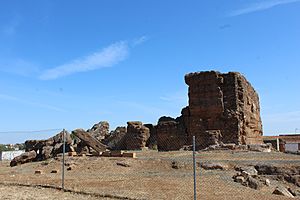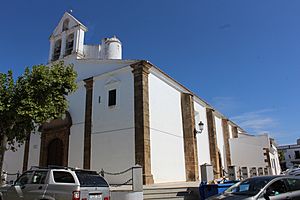Villanueva del Fresno facts for kids
Quick facts for kids
Villanueva del Fresno
|
|
|---|---|
 |
|
| Country | |
| Autonomous community | |
| Province | Badajoz |
| Comarca | Llanos de Olivenza |
| Area | |
| • Total | 360 km2 (140 sq mi) |
| Elevation | 256 m (840 ft) |
| Population
(2018)
|
|
| • Total | 3,401 |
| • Density | 9.45/km2 (24.5/sq mi) |
| Time zone | UTC+1 (CET) |
| • Summer (DST) | UTC+2 (CEST) |
Villanueva del Fresno is a town in the Badajoz Province in Extremadura, Spain. It's located in the southern part of the Olivença area. The town is very close to the border with Portugal, which means it has a lot of trade and connections with its neighbor.
Contents
History of Villanueva del Fresno
People have lived in the Guadiana Valley for a very long time, even since prehistoric times! We know this because tools and signs from the Stone Age have been found here. One of the oldest important sites is a settlement called Cunco Castle. It was likely built by Islamic people long ago, near the Ribeira de Cuncos and the Guadiana River.
A Town of Battles and Changes
The area around Villanueva del Fresno was often fought over. This happened during the Reconquista, when Christian kingdoms took back land from Muslim rule in Spain. Later, it was also a battleground when Portugal fought for its independence from Spain. During this time, the town was even called "Vila Nova de Portugal" for a while.
In the late 1200s, Villanueva del Fresno was part of the Knights Templar's lands. The Knights Templar were a famous group of warrior monks. But in 1312, the Pope ended their order.
The Portocarrero Family and the Castle
In 1332, King Alfonso XI gave a lot of land around the town to his trusted helper, Martin Fernandez Portocarrero. His family became very powerful and were known as the Lords of Moguer and Villanueva del Fresno. In 1530, one of them, Juan Portocarrero, was made a Marquise by Charles V, the Holy Roman Emperor. This family became one of the most important in Spain.
During the 1300s, a strong tower called the Tower of Homage was added to the town's castle. This helped protect the town and the border with Portugal. The Portuguese attacked Villanueva many times, but most attacks were stopped. However, in 1643, a Portuguese army captured the town and its castle after a long fight. Both were completely destroyed in 1646 during the Portuguese Restoration War.
Rebuilding the Town
About 25 years later, after a peace treaty was signed in 1668, the town began to be rebuilt. The "new" Villanueva del Fresno was built on the other side of a hill from the old one. Many of the new residents were from Portugal. The rebuilt town was designed with wide streets and clear plots of land, which you can still see today.
Population Growth Over Time
The number of people living in Villanueva del Fresno has changed a lot over the years. Here's a look at how the population has grown and shrunk:
| Population growth of Villanueva del Fresno between 1900 y 2007 | ||||||||||||||||||||||||
|---|---|---|---|---|---|---|---|---|---|---|---|---|---|---|---|---|---|---|---|---|---|---|---|---|
| 1900 | 1910 | 1920 | 1930 | 1940 | 1950 | 1960 | ||||||||||||||||||
| 4393 | 4692 | 5387 | 6430 | 6535 | 6585 | 6621 | ||||||||||||||||||
| 1970 | 1981 | 1991 | 1996 | 1999 | 2007 | |||||||||||||||||||
| 4253 | 3469 | 3295 | 3449 | 3522 | 3610 | |||||||||||||||||||
Architecture and Fun Places to See
Today, only parts of the old fortress remain. The area where the castle walls once stood has been turned into an open-air theater! This castle was first built in the 1400s with strong walls and towers. But, as you read, it was destroyed a couple of centuries later.
Exploring the Town's Streets
The town rebuilt in the 1600s has many traditional two-story houses. They are often sun-bleached and look very charming. You can see them on streets like Hilario Lopez, Nueva, San Juanito, and Portocarrero. Some houses have beautiful trellises (wooden frames for climbing plants), fancy doorways, and balconies.
The main meeting point in town is the Plaza de España. It's a large, open square. Here you'll find the historic town hall building and the main church, Our Lady of the Conception.
Other Historic Sites and Nature
You can also visit other old places like the Pilar del Conde and de la Mora. There are three small chapels (called hermitages) dedicated to San Antonio, San Gínes de la Jara, and Cristo de la Expiracion. You can also see parts of an old aqueduct (a water channel) and a restored medieval fortress on the way to Alconchel.
The area around Villanueva del Fresno is also great for nature lovers! It has beautiful natural spots that are perfect for hiking, hunting, and fishing.
Wildlife and Reservoirs
The Rio Alcarrache area is a special place for wildlife. You might spot rare birds like eagle owls and black storks, or even wildcats! The Sierra de Jerez is another important area, especially in winter, when many storks and other birds from northern Europe come to stay.
There are also two large dams nearby, which create big lakes called reservoirs. These are at Cunco and Aquelva (in Portugal). You can go fishing in these reservoirs, and there are special spots to watch the birds and enjoy the views.
Delicious Local Food
When you visit Villanueva del Fresno, you should try the local food! Some popular dishes include Iberian ham, lamb, and rabbit cooked in the local style. If you're there in the right season, you might find wild edible mushrooms collected from the fields. These include "parasols" (a type of mushroom), "gurumelos," and "boletus edulis."
Fun Local Celebrations
Villanueva del Fresno has many exciting festivals throughout the year!
Carnival
Carnival happens at the start of Lent, so its date changes each year. It kicks off on the Friday evening before Ash Wednesday with a fun procession. People dress up in costumes and masks, sometimes playfully "frightening" those they meet! Saturday is the big day, with another evening procession to the football stadium. Here, singing groups called comparsas gather. They then parade through town to the Plaza de España, singing funny and often satirical songs. On Sunday, there's another procession with both adult and children's singing groups. The carnival ends on Shrove Tuesday evening with the "Burial of the Sardine" ceremony. This involves burning a symbolic item, marking the end of the celebrations.
The Gurumelo Food Festival
This festival takes place one weekend in March, usually close to March 19th, which is Father's Day in Spain. "Gurumelos" are a type of edible mushroom. The festival brings everyone together for a food and crafts fair, celebrating these special mushrooms.
St. Ginés de la Jara Romeria
This festival celebrates the town's patron saint and happens on the first Monday in May. It's a day to spend outdoors near the St. Ginés hermitage (chapel). The day starts with music from the town band and fireworks. At 10:00 AM, there's a parade and competition for decorated carriages around the Plaza de España. A mass is held at the hermitage at midday, followed by a procession with music. After prizes are given for the carriages, the party and picnic begin, lasting late into the night!
Other Important Dates
- Feast of the Virgin of Fatima: Celebrated on May 13th.
- Feast of St. Juanito: Celebrated on June 24th.
- Feast of St. Christopher (for drivers): Held in mid-August. There's an outdoor mass for St. Christopher, followed by a parade of vehicles, which are then blessed.
- Fair and Festival of St. Gínes de la Jara: This big fair and festival takes place at the end of August, with the main day being the 25th. It lasts for five days and includes many activities for children in the Plaza de España.
- The Feast of Holy Christ of the Expiration: Celebrated on September 14th. The celebration starts on September 3rd when a statue of Christ is moved from the hermitage to the church for a special nine-day prayer (novena). On the 14th, there's a sangria tasting. In the evening, the statue of Christ is returned to the hermitage, where it meets a statue of the Virgin of Solitude. This statue then goes to the church for a three-day prayer (triduum).
- Extremadura Day: Celebrated on September 7th.
- Feast of the Gamona: This is a local New Year's Eve tradition. Before the family meal, many people, especially younger ones, build bonfires. They burn bundles of dried plant stems called "St. Joseph's Wands" or "gamonas." The exact reason for this tradition is a bit of a mystery!
Famous People from Villanueva del Fresno
- Estéban de Perea
- Pedro Portocarrero
- Pedro de Quevedo y Quintano
- José Antonio Saravia
See also
 In Spanish: Villanueva del Fresno para niños
In Spanish: Villanueva del Fresno para niños





